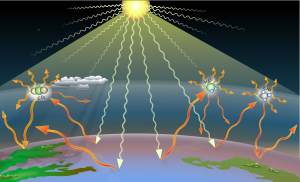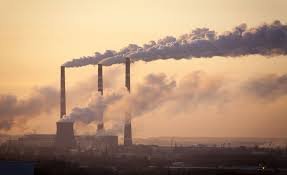
The greenhouse effect is a process that occurs when energy from a planet's Sun goes through its atmosphere and warms the planet's surface, but the atmosphere prevents the heat from returning directly to space, resulting in a warmer planet. Light arriving from our Sun passes through Earth's atmosphere and warms its surface. The warmed surface then radiates heat, absorbed by greenhouse gasses such as carbon dioxide. Earth's average temperature would be well below freezing without the natural greenhouse effect. Current human-caused increases in greenhouse gasses trap greater amounts of heat, causing the Earth to grow warmer over time.
Anything warmed radiates energy related to its temperature – the Sun at about 5,500 °C (9,930 °F) sends most as visible and near-infrared light, while Earth's average surface temperature about 15 °C (59 °F) emits longer wavelength infrared radiant heat. The atmosphere is transparent to most incoming sunlight and allows its energy to the surface. The term greenhouse effect comes from a flawed analogy comparing this to transparent glass allowing sunlight into greenhouses, but greenhouses mainly retain heat by restricting air movement, unlike this effect. Most of the atmosphere is transparent to infrared, but a tiny proportion of greenhouse gasses makes it almost completely opaque to wavelengths emitted by the surface. Greenhouse gas molecules absorb and emit this infrared, so heat up and emit radiant heat in all directions, warming other greenhouse gas molecules and passing heat on to the surrounding air. Radiant heat going downwards further increases the surface temperature, adding to energy going up into the atmosphere. Without Earth's natural greenhouse effect, the Earth would be more than 30 °C (54 °F) colder.
Sunlight varies day and night, by season, and distance from the equator. Half of the available sunlight is reflected from clouds and the Earth's surface, depending on their reflectivity. Greenhouse gasses vary in effect, time in the atmosphere, and altitude, leading to positive feedback. Variations are evened out by Earth's heat engine, causing energy flows. Eventually, higher layers of the atmosphere tend to emit about as much energy into space as is arriving from the Sun, forming Earth's energy balance. A runaway greenhouse effect occurs if positive feedback leads to the evaporation of greenhouse gasses into the atmosphere, as happened with carbon dioxide and water vapour on Venus.

Outstanding
Downvoting a post can decrease pending rewards and make it less visible. Common reasons:
Submit
Nice content
Downvoting a post can decrease pending rewards and make it less visible. Common reasons:
Submit